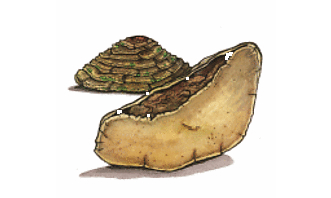Source of Information: Memorial Sloan Kettering Cancer Center, the oldest and largest private cancer center, located in New York, founded in 1884.
Scientific Name: Phellinus linteus
Common Name: Meshimakobu, song gen, sanghuang, sang-hwang

How It Works
Bottom Line: Phellinus linteus a medicinal mushroom, showed anticancer effects in lab studies. Clinical trials are needed to establish its anticancer potential.
Phellinus linteus (PL) is a medicinal mushroom used in traditional medicine in Asia. Compounds present in this mushroom have anti-inflammatory and antitumor properties. Large scale studies are needed to confirm these effects.
- To treat aging and wrinkles
Phellinus linteus is used to prevent aging, and specifically to eliminate or prevent wrinkles, but research evidence is lacking. - To inhibit tumor growth
Phellinus linteus has been shown in some lab studies to inhibit tumor growth but it has not been subjected to clinical trials.
Although PL is used as cancer treatment in Asia, large scale clinical trials are lacking. A few cases of regression of liver and prostate cancer have been reported. Such observations need to be confirmed in clinical studies.
PL use resulted in worsening of an autoimmune condition called pemphigus that is characterized by blisters on the skin and mucous membranes and by itching or burning.
Phellinus linteus (PL) is a yellow, bitter-tasting mushroom that grows on mulberry trees. It is used in traditional medicine in Asia where it is often mixed with other medicinal mushrooms, such as Reishi and Maitake, and promoted as an adjunctive treatment during cancer therapy. Some preparations of PL are used to prevent wrinkles and aging but clinical evidence is lacking. The polysaccharide-protein complexes found in PL were shown to have immunomodulating effects (1). The polyphenolic constituent demonstrated anti-inflammatory properties, which may protect against injury and other syndromes involving infarcts, hematomas or hemorrhages in animal models (2) (3). Other constituents, such as interfungins A, help prevent protein modification in hyperglycemic state, and may benefit diabetics (4).
PL is being researched for its potential chemoprotective effects. A number of in vitro and animal studies suggest that it has anti-angiogenic, antioxidant, and xanthine oxidase inhibition properties (5). Anticancer effects against breast (6) (7) (8), colon (9) (10), liver (11), lung (12) (13), oral (14), prostate (15) (16) (17) and skin cancers (18) (19) (1) have also been reported.
While there are case reports of tumor regression following consumption of PL (11) (20) (21), large scale clinical studies have yet to be conducted to examine its efficacy as a cancer treatment.
- Anti-hemorrhagic
- Anti-inflammatory
- Cancer treatment and prevention
- Protocatechuic acid
- Protocatechualdehyde
- Caffeic acid
- Ellagic acid
- Hispidin
- Davallialactone
- Hypholomine B
- Interfunging A
- Inoscavin A
- Meshimakobnol A
- Meshimakobnol B
- Phelligridin G
- Phellifuropyranone A
The polysaccharide-protein complexes found in PL have immunomodulating (1), anti-angiogenic, and antioxidant and xanthine oxidase inhibition effects (5). Additionally, the furopyranone compounds inhibit protein glycation, which may aid in treatment and prevention of diabetic complications (4) (23). In non-obese diabetic mice, a polysaccharide extract from PL enhanced function of macrophages, dendritic cells, NK cells, T cells and B cells, prevented inflammation by inhibiting IFN-gamma, IL-2 and TNF-alpha by TH1 cells and macrophages; it also upregulated IL-4 expression in TH2 cells. These effects may help prevent diabetes (23). The anti-inflammatory activities of inotilone, a compound isolated from PL might be due to reduced levels of malondialdehyde (MDA), inducible nitric oxide synthase (iNOS), COX-2, NF-κB, and matrix metalloproteinase (MMP)-9, and via increased activities of catalase (CAT), superoxide dismutase (SOD), and glutathione peroxidase (GPx) through the suppression of TNF-α and nitric oxide (NO) (25). In another study, hispidin, a phenolic compound present in PL, was shown to protect against peroxynitrite-mediated cytotoxicity, DNA damage and hydroxyl radical formation (26).
PL also inhibited proliferation of SW480, a human colon cancer cell line via decreasing Bcl-2 and cyclin B1, and increasing cytochrome C (9). Another study similarly found that a PL extract induced G0/G1 arrest and apoptosis in human colon carcinoma HT29 cells, through p21(C1P1/WAF1) upregulation, cyclin D1 downregulation, Bcl2 downregulation, release of cytochrome C and activation of caspases 9, 3 and 8 (10). Decrease in cyclin-dependent kinases CDK2, 4 and 6, and dose-dependent apoptosis of lung cancer cells after treatment with PL were also observed (12). Further, it suppressed aryl hydrocarbon receptor activity and AhR-dependent gene expression, both pathways activated by cigarette smoking (13).
Exacerbation of pemphigus (an autoimmune disorder) was reported following use of PL (24).
Purpose of this published study is scientific information and education, it should not be used for diagnosing or treating a health problem or disease. This website is designed for general education and information purposes only and does not substitute for professional medical advice, examination, diagnosis or treatment.
Source of Information: Memorial Sloan Kettering Cancer Center, the oldest and largest private cancer center, located in New York, founded in 1884.
- Kim GY LJ, Lee JO, Ryu CH, Choi BT, Jeong YK, Lee KW, Jeong SC, Choi YH. Partial characterization and immunostimulatory effect of a novel polysaccharide-protein complex extracted from Phellinus linteus. Biosci Biotechnol Biochem. May 2006;70(5):1218-1226.
- Chang HY SM, Yang CH, Lu TC, Chang YS, Peng WH, Huang SS, Huang GJ. Analgesic Effects and the Mechanisms of Anti-Inflammation of Hispolon in Mice. Evid Based Complement Alternat Med. Apr 6. 2009
- Suzuki S KT, Okada Y, Kobayashi T, Nakamura T, Hori T. Filtrate of Phellinus linteus Broth Culture Reduces Infarct Size Significantly in a Rat Model of Permanent Focal Cerebral Ischemia. Evid Based Complement Alternat Med. Jan 20. 2009.
- Lee YS KY, Jung JY, Lee S, Ohuchi K, Shin KH, Kang IJ, Park JH, Shin HK, Lim SS. Protein glycation inhibitors from the fruiting body of Phellinus linteus. Biol Pharm Bull. Oct 31 2008;31(10):1968-1972.
- Song YS, Kim SH, Sa JH, Jin C, Lim CJ, Park EH. Anti-angiogenic, antioxidant and xanthine oxidase inhibition activities of the mushroom Phellinus linteus. J Ethnopharmacol. Sep 2003;88(1):113-116.
- Sliva D, Jedinak A, Kawasaki J, Harvey K, Slivova V. Phellinus linteus suppresses growth, angiogenesis and invasive behaviour of breast cancer cells through the inhibition of AKT signalling. Br J Cancer. 2008 Apr 22;98(8):1348-56.
- Lu TL HG, Lu TJ, Wu JB, Wu CH, Yang TC, Iizuka A, Chen YF. Hispolon from Phellinus linteus has antiproliferative effects via MDM2-recruited ERK1/2 activity in breast and bladder cancer cells. Food Chem Toxicol. Aug 2009;47(8):2013-2021.
- Sliva D JA, Kawasaki J, Harvey K, Slivova V. Phellinus linteus suppresses growth, angiogenesis and invasive behaviour of breast cancer cells through the inhibition of AKT signalling. Br J Cancer. Apr 22 2008;98(8):1348-1356.
- Li G KD, Kim TD, Park BJ, Park HD, Park JI, Na MK, Kim HC, Hong ND, Lim K, Hwang BD, Yoon WH. Protein-bound polysaccharide from Phellinus linteus induces G2/M phase arrest and apoptosis in SW480 human colon cancer cells. Cancer Lett. Dec 28 2004;216(2):175-181.
- Park HJ CS, Hong SM, Hwang SG, Park DK. The ethyl acetate extract of Phellinus linteus grown on germinated brown rice induces G(0)/G(1) cell cycle arrest and apoptosis in human colon carcinoma HT29 cells. Phytother Res. 2010 Jul;24(7):1019-26.
- Nam SW, Han JY, Kim JI, et al. Spontaneous regression of a large hepatocellular carcinoma with skull metastasis. J Gastroenterol Hepatol. Mar 2005;20(3):488-492.
- Guo J ZT, Collins L, Xiao ZX, Kim SH, Chen CY. Modulation of lung cancer growth arrest and apoptosis by Phellinus Linteus. Mol Carcinog. Feb 2007;46(2):144-154.
- Mukai M KA, Hiramatsu N, Hayakawa K, Okamura M, Tagawa Y, Yao J, Nakamura T, Kitamura M. Blockade of the aryl hydrocarbon receptor pathway triggered by dioxin, polycyclic aromatic hydrocarbons and cigarette smoke by Phellinus linteus. Biol Pharm Bull. Oct 2008;31(10):1888-1893.
- Chen W HF, Li YQ. The apoptosis effect of hispolon from Phellinus linteus (Berkeley & Curtis) Teng on human epidermoid KB cells. J Ethnopharmacol. Apr 21 2006;105(1-2):280-285.
- Collins L ZT, Guo J, Xiao ZJ, Chen CY. Phellinus linteus sensitises apoptosis induced by doxorubicin in prostate cancer. Br J Cancer. Aug 7 2006;95(3):282-288.
- Tsuji T DW, Nishioka T, Chen L, Yamamoto D, Chen CY. Phellinus linteus extract sensitizes advanced prostate cancer cells to apoptosis in athymic nude mice. PLoS One. Mar 31 2010;5(3):e9885.
- Zhu T GJ, Collins L, Kelly J, Xiao ZJ, Kim SH, Chen CY. Phellinus linteus activates different pathways to induce apoptosis in prostate cancer cells. Br J Cancer. Feb 26 2007;96(4):583-590.
- Han SB LC, Kang JS, Yoon YD, Lee KH, Lee K, Park SK, Kim HM. Acidic polysaccharide from Phellinus linteus inhibits melanoma cell metastasis by blocking cell adhesion and invasion. Int Immunopharmacol. Apr 2006;6(4):697-702.
- Lee HJ LH, Lim ES, Ahn KS, Shim BS, Kim HM, Gong SJ, Kim DK, Kim SH. Cambodian Phellinus linteus inhibits experimental metastasis of melanoma cells in mice via regulation of urokinase type plasminogen activator. Biol Pharm Bull. Jan 2005;28(1):27-31.
- Shibata Y, Kurita S, Okugi H, Yamanaka H. Dramatic remission of hormone refractory prostate cancer achieved with extract of the mushroom, Phellinus linteus. Urol Int. 2004;73(2):188-190.
- Kojima H TN, Kariya S, Komemushi A, Shomura Y, Sawada S, Arai E, Yokota Y. A case of spontaneous regression of hepatocellular carcinoma with multiple lung metastases. Radiat Med. Feb 2006;24(2):139-142.
- Kojima K OT, Inoue M, Mizukami H, Nagatsu A. Phellifuropyranone A: a new furopyranone compound isolated from fruit bodies of wild Phellinus linteus. Chem Pharm Bull (Tokyo). Feb 2008;56(2):173-175.
- Kim HM KJ, Kim JY, Park SK, Kim HS, Lee YJ, Yun J, Hong JT, Kim Y, Han SB. Evaluation of antidiabetic activity of polysaccharide isolated from Phellinus linteus in non-obese diabetic mouse. Int Immunopharmacol. Jan 2010;10(1):72-78.
- Jin SP, Hong JS, Chung JH. Exacerbation of pemphigus following Phellinus linteus ingestion. J Eur Acad Dermatol Venereol. 2011 Apr;25(4):492-3.
- Huang GJ, Huang SS, Deng JS. Anti-inflammatory activities of inotilone from Phellinus linteus through the inhibition of MMP-9, NF-κB, and MAPK activation in vitro and in vivo.PLoS One. 2012;7(5):e35922.
- Chen W, Feng L, Huang Z, Su H. Hispidin produced from Phellinus linteus protects against peroxynitrite-mediated DNA damage and hydroxyl radical generation.Chem Biol Interact. 2012 Sep 30;199(3):137-42.
